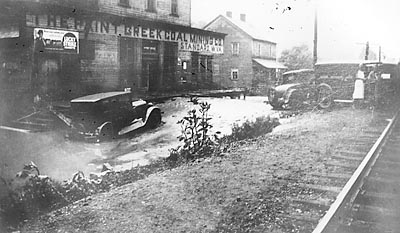“Water from Hill to Hill”
Recalling the Paint Creek Flood of 1932
By Matthew Mitchell

A devastating flash flood along Paint Creek in southern
Kanawha County on July 11, 1932, caused widespread damage and at least
18 deaths. Here, cars are forced off the road at the Paint Creek Coal
company store in Standard, the day after the disaster. Photograph courtesy
of the West Virginia State Archives.
Paint Creek is a long, winding tributary of the Kanawha River. Starting in Raleigh County, the clayish-colored waters for which many believe the creek is named flow nearly 100 miles, passing through Fayette County, running south through Kanawha County, until finally joining the Kanawha River at the small town of Pratt.
Though many coal companies mined the mountainsides and large coal communities lined its banks, the people living along Paint Creek were experiencing hard times in 1932. Roland “Joe” Savilla was 16 years old and a resident of Livingston, a town four miles from Pratt. Now a resident of St. Albans, Joe recalls that Paint Creek was “beginning to feel the full impact of the Depression,” at that time. The coal community of Livingston was losing more and more miners. Their houses were barren, waiting for better times, he says.
James “Jeep” Hall of Gallagher was 10 years old and was a friend of Joe Savilla’s brother Sammy. As Jeep remembers, “Times was hard. If we had a couple ole biscuits with potted meat or something on ‘em to take to school, that was something. [Sammy] used to bring me a peanut butter and banana sandwich all the time.”
Paint Creek had already experienced its share of tough times. In 1912, it was the site of a pivotal chapter in the infamous West Virginia Mine Wars. [See “Three Sides to the Story: Governor Hatfield and the Mine Wars,” by Joseph Platania; Summer 1985.] According to historical accounts, coal operators, refusing to recognize the union, hired armed guards to evict protesting miners from company homes. Joe Savilla’s mother witnessed firsthand the cruelty of these guards. “Mother was seven months pregnant back in the strike of 1912,” he says. “One of the guards came to our house and asked Mother where my father was. She said he had gone to Ohio to look for work there in the coal mines of Ohio. Well, they didn’t like that answer, and one of the guards clenched his fist and hit her in the stomach. She had to go to the hospital prematurely to give stillbirth to a boy.”
Twenty years later, men and women at Paint Creek still carried the unpleasant memories of a labor war, which, according to accounts, left 13 miners and mine guards dead.
But on July 11, 1932, more hard times were in store. That day, a cloudburst poured vehemently from the sky, and the townspeople were forced to take shelter. Joe Savilla recalls, “It was towards evening, and the sky really had what we call a threatening look. It was dark, [there was] some wind and thunder. It really had the atmosphere of [impending] danger. It really did.”
Ann Adkins, now of Gallagher, was six years old and living in Livingston. As she remembers, “That night it just rained, rained, rained. It was just a cloudburst, is what it was, I guess, at the head of the holler. I remember all of us kids laying across the bed — we lay crossways in the bed, five kids and Mom. We watched the lightning, and it kept the sky just bright. Oh, it was just lightning awful.”
You can read the rest of this article in this issue of Goldenseal, available in bookstores, libraries or direct from Goldenseal.